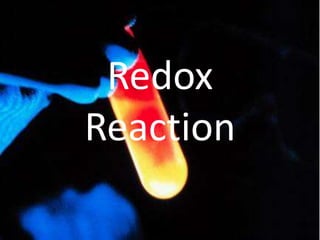
Redox reaction Group C
- 3. Oxidation is a reaction where oxygen combines with an element/compound to form another substance
- 4. Oxidation – Gain of oxygen When calcium burns in oxygen, the following reaction takes place calcium + oxygen calcium oxide 2Ca(s) + O2 2CaO(s) Since calcium has gained oxygen. It has be oxidised. Hence this is oxidation.
- 5. Oxidation – Loss of Hydrogen When ammonia is passed over heated copper(II) oxide, the following reaction takes place. ammonia + copper(II) oxide nitrogen + copper + water vapour 2NH3(g) + 3CuO(s) N2(g) + 3Cu(s) + 3H2O(g) Since ammonia has lost hydrogen, it has been oxidised.
- 6. Oxidation – Loss of Electrons Oxidation can still take place despite having no oxygen/hydrogen. When a substance loses electrons it is considered oxidation. magnesium + chlorine magnesium chloride Mg(s) + Cl2(g) MgCl2(s)
- 8. Definition Of Reduction • Reduction is a chemical reaction where it loses oxygen, gain hydrogen, gain electron and have a decrease in oxidation state by a molecule, atom or ion. • A reactant that reduces another substance is a reducing agent. • The reducing agent transfers electrons to another substance, it reduces others, and is thus itself oxidized. And, because it "donates" electrons, it is also called an electron donor.
- 9. Reduction-Loss Of Oxygen When zinc burns in copper(II) oxide, the following reaction takes place. Zinc + copper oxide Zinc oxide + copper Zn(s)+CuO(s) ZnO(s)+Cu(s) Since Zinc has gain oxygen,it is oxidised. Copper(II) oxide loses oxygen,thus it is reduced.
- 10. Reduction-Gain Of Hydrogen When nitrogen burns with hydrogen gas, the following reaction takes place. Nitrogen +Hydrogen Ammonia N2 + 3H2 2NH3 Nitrogen gain hydrogen, thus it is being reduced.
- 11. Reduction-Gain Of Electron When iron reacts with chloride acid, the following reaction takes place. Iron + chlorine Iron(III) + Chloride 2Fe2++Cl2 2Fe3++2Cl- Since iron loses electron, it is oxidised. Chlorine gains electron, thus it is reduced.
- 12. Common Reducing Agent • Lithium aluminium hydride (LiAlH4) • Nascent (atomic) hydrogen • Sodium amalgam • Diborane • Sodium borohydride (NaBH4) • Compounds containing the Sn2+ ion, such as tin(II) chloride • Sulfite compounds • Hydrazine (Wolff-Kishner reduction) • Zinc-mercury amalgam (Zn(Hg)) (Clemmensen reduction) • Diisobutylaluminum hydride (DIBAL-H) • Lindlar catalyst • Oxalic acid (C2H2O4) • Formic acid (HCOOH) • Ascorbic acid (C6H8O6) • Phosphites, hypophosphites, and phosphorous acid • Dithiothreitol (DTT) – used in biochemistry labs to avoid S-S bonds • Compounds containing the Fe2+ ion, such as iron(II) sulfate • Carbon monoxide(CO) • Carbon (C)
- 13. Oxidation State
- 14. The oxidation state is the charge an atom of an element would have if it existed as an ion in a compound.
- 15. To work out the oxidation state of an atom, we apply the following rules: Rule Example Oxidation state 1. The oxidation state of a Cu, S, Cl2 0, 0, 0 free element is zero. 2. The oxidation state of a K+, Zn2+, Cl-, O2- +1, +2, -1, -2 simple ion is the same as the charge on the ion. 3. The oxidation states of Ca, C, 3O +2, +4, 3x(-2)=-6 the atoms present in the formula of a compound All add up to zero. add up to zero. The example shown here is CaCO3 . 4. The total of the S, 4O +6, 4x(-2)=-6 oxidation states of the atoms in a polyatomic ion All add up to -2. is equal to the charge on the ion. The example shown here is SO4 2- .
- 16. Solution to question: Find the oxidation state of each element in ammonium sulfate. (NH4)2SO4 Since hydrogen in NH4 has an o.s of +1, Ammonium has a charge of 1. Let n be x 2(x+4(1))=2 2x-2-8 x=-3 Hence nitrogen has an o.s of -3
- 17. Since oxygen in SO4 has an o.s of -2, Sulfate has a charge of -2. Let s be y y+4(-2)=-2 y-8=-2 y=6 Hence sulfur has an o.s of 6.
- 19. Done by • Edwin • Kian Leong • Jeremy • Melvan